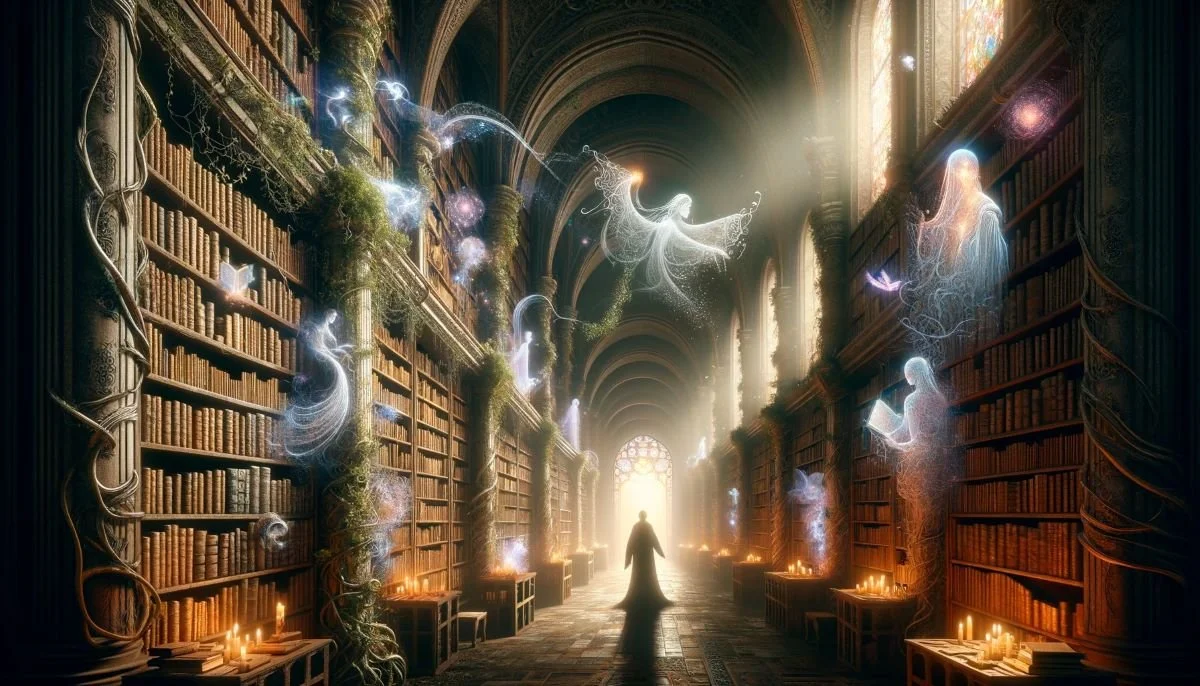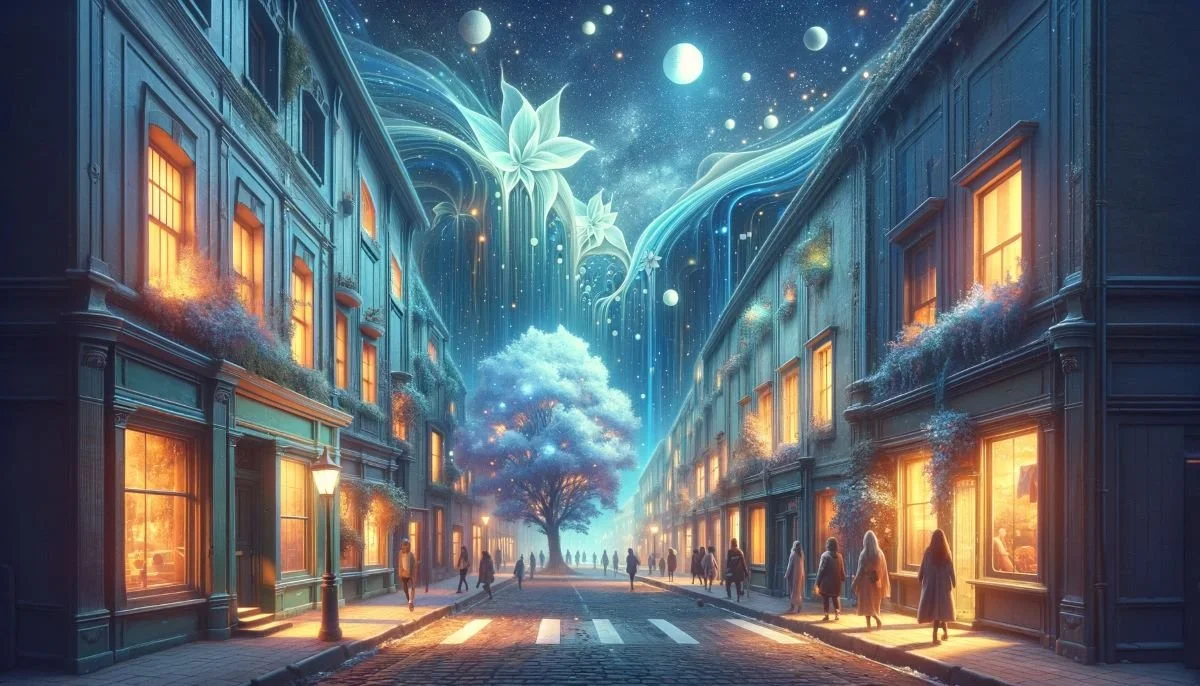We’re about to embark on a historical adventure, tracing the origins and development of Magical Realism in literature. From its early artistic beginnings to its flowering in literary works, this article will explore how this genre emerged as a unique narrative style, reflecting cultural, social, and political contexts. Get ready to uncover the rich and multifaceted history behind one of literature’s most intriguing genres.
Introduction: The Enchanting Emergence of Magical Realism
Imagine a world where the flutter of a butterfly can echo the secrets of the universe, or a raindrop holds a thousand stories. This is the realm of Magical Realism, a literary genre where the mundane tapestry of everyday life is interlaced with threads of the marvelous and the surreal. Magical Realism invites us on a journey where reality is not just what we see and touch; it’s imbued with enchantment, making the ordinary world shimmer with hidden wonders.
This genre, with its unique blend of the real and the fantastical, has captivated the hearts of readers and writers alike, offering a fresh perspective on storytelling. It’s a narrative style that defies strict rules, where the miraculous coexists seamlessly with the routine, and the line between the possible and the impossible becomes beautifully blurred.
In the following exploration, we will delve into the origins of Magical Realism, tracing its evolution from its earliest artistic expressions to its flourishing in literature. We’ll discover how this genre has transcended cultural and geographical boundaries, becoming a voice for diverse experiences and worldviews. Through its growth and transformation, Magical Realism has emerged not just as a way of writing, but as a way of seeing the world – a lens that reveals the hidden magic in the ordinary, and the extraordinary depth in everyday life. Join us as we unravel the tapestry of Magical Realism, where every thread tells a story of wonder.
The Artistic Beginnings: Magical Realism’s First Brush Strokes
Magical Realism, as we know it in literature today, has its roots in an artistic movement that emerged in the early 20th century. This genre’s first whispers were heard not in the turning of pages, but in the strokes of paintbrushes, where artists began to explore a new way of seeing and depicting the world.
Artistic Roots in the 1920s
In the 1920s, the art world witnessed the birth of Magical Realism, a term first used by German art critic Franz Roh to describe a new style of painting. This style sought to capture the ordinary world in an extraordinary light. The artists of this movement painted everyday scenes with meticulous detail, but with an added layer of surrealism, making the familiar seem strange and otherworldly.
These paintings often portrayed ordinary objects and people but in ways that hinted at hidden meanings and deeper realities. The result was artwork that felt anchored in reality yet stretched beyond it, inviting viewers to look closer and question what they saw. Unlike pure surrealism, which delved into the fantastical, Magical Realism in painting stayed grounded in the real world, yet subtly distorted it to evoke a sense of wonder.
Cultural and Philosophical Influences
The emergence of Magical Realism in art was not an isolated phenomenon; it was a response to the broader cultural and philosophical currents of the time. Two significant influences were surrealism and existentialism.
Surrealism: While surrealism sought to unlock the mysteries of the unconscious mind, often through fantastical and bizarre imagery, Magical Realism borrowed its dream-like quality. The surrealists’ exploration of deeper truths hidden beneath the surface of the real world resonated with Magical Realist artists, who sought to reveal these truths through a more subtle distortion of reality.
Existentialism: The existentialist movement, with its focus on individual experience and the search for meaning in an ambiguous world, also influenced Magical Realism. This philosophical perspective offered a way of looking at the world that acknowledged its complexities and mysteries. It led artists and, later, writers to explore themes of identity, existence, and reality through a magical lens.
In these artistic and philosophical beginnings, Magical Realism found its voice. It was a voice that spoke of the beauty and mystery of the everyday world, urging viewers and readers alike to see beyond the apparent and discover the magic hidden in plain sight. These early brush strokes laid the foundation for what would become a rich and diverse literary genre, one that continues to enchant and inspire with its unique vision of reality.
Transition to Literature: From Canvas to Paper
The journey of Magical Realism from the evocative strokes of a paintbrush to the vivid imagery of written words marks a fascinating evolution of the genre. As it transitioned into literature, Magical Realism found a new canvas in the pages of books, where authors breathed life into its unique narrative style, imbuing it with cultural depth and diversity.
Early Literary Adopters
In the realm of literature, Magical Realism found a new voice. Early literary adopters of this genre took the surreal, dreamlike elements from the canvas and wove them into the fabric of their narratives. This period saw authors experimenting with the blending of the real and the fantastical in a way that challenged readers’ perceptions of reality.
Franz Kafka: One of the pioneers in integrating Magical Realism into literature was Franz Kafka. His works, notably “The Metamorphosis,” showcase the genre’s hallmark features – the blending of the mundane with the bizarre, creating a world that is both familiar and unsettling.
Jorge Luis Borges: Argentinian author Jorge Luis Borges is another key figure in the early literary adoption of Magical Realism. His short stories, rich with symbolism and metaphysical puzzles, presented a reality where the extraordinary was seamlessly integrated into the everyday.
Global Spread and Adaptation
Magical Realism’s journey from European literature to a global phenomenon is a testament to its universal appeal and adaptability. The genre found particularly fertile ground in Latin America, where it resonated deeply with the region’s cultural, historical, and social context.
Latin American Boom: The mid-20th century witnessed a boom in Latin American literature, with authors like Gabriel García Márquez and Isabel Allende becoming synonymous with Magical Realism. In their narratives, the magical elements served as metaphors for political and social commentary, reflecting the complexities of life in Latin America.
Cultural Integration and Diversification: As Magical Realism spread across continents, authors from various cultures began to infuse the genre with their unique perspectives and experiences. In Africa, writers like Ben Okri incorporated elements of African folklore and myth, while in Asia, authors like Haruki Murakami blended the genre with elements of Eastern philosophy and spirituality.
The global spread and adaptation of Magical Realism in literature show how a genre can transcend its origins and become a voice for diverse experiences and worldviews. Through its evolution, Magical Realism has become a rich and varied tapestry of storytelling, offering readers a glimpse into different cultures and histories, all the while reminding us that magic can be found in the most unexpected places.
Magical Realism’s Golden Era: The Latin American Boom
The mid-20th century marked a defining moment in the history of Magical Realism, particularly in Latin America, where the genre not only flourished but also took on new dimensions. This period, often referred to as the “Latin American Boom,” saw Magical Realism evolve into a powerful tool for storytelling, deeply rooted in the region’s unique cultural, political, and social landscape.
The Latin American Explosion
During this era, Latin American writers embraced Magical Realism, turning it into a distinctive voice that resonated across the globe. The works of these authors were not just stories; they were tapestries woven with the threads of fantasy and reality, reflecting the complexities of Latin American life.
Gabriel García Márquez: Perhaps the most iconic figure of this movement was Colombian author Gabriel García Márquez. His masterpiece, “One Hundred Years of Solitude,” is a seminal work of Magical Realism. Márquez created a narrative where time is cyclical, history repeats, and the magical is mundane, painting a vivid picture of Latin American culture and history.
Isabel Allende: Chilean author Isabel Allende is another prominent figure of this era. Her novel, “The House of the Spirits,” intertwines family sagas with the turbulent political backdrop of Chile. Allende’s narrative is rich with magical elements, providing a unique lens through which to view the country’s history and societal issues.
Themes and Styles
The works of Latin American Magical Realists are characterized by certain recurring themes and narrative styles that set them apart.
Political and Social Commentary: Many Latin American Magical Realist authors used the genre to explore and critique political and social realities. The magical elements in their stories often served as metaphors for real-world issues like dictatorship, colonialism, and class struggles, allowing authors to comment on these themes in a way that was both engaging and provocative.
Blending the Mythical and the Mundane: Another hallmark of Latin American Magical Realism is the seamless blending of mythical elements with everyday life. These stories are set in recognizable landscapes, populated with characters who experience the fantastical as part of their daily existence.
Rich Narrative Style: The narrative style of Latin American Magical Realism is often characterized by lush, detailed descriptions and a fluid approach to time and reality. This style creates a dreamlike quality, where the boundaries between reality and fantasy are blurred, and the magical becomes a natural part of the world.
The Golden Era of Magical Realism in Latin America not only brought global attention to the genre but also expanded its boundaries. The works of these authors remain enduring classics, continuing to inspire and captivate readers with their unique blend of the real and the magical. Through their narratives, they have immortalized the beauty, complexity, and magic of Latin American culture and history.
Magical Realism Today: A Living Legacy
In the ever-evolving landscape of literature, Magical Realism continues to enchant and inspire, transcending time and geographical boundaries. Today, a new generation of writers is carrying the torch of this mesmerizing genre, infusing it with contemporary sensibilities and expanding its horizons. Let’s explore how Magical Realism is being reimagined in the modern literary world and its enduring impact on global literature.
Contemporary Works and Writers
The essence of Magical Realism is alive and thriving in the works of contemporary authors who are pushing the genre into new territories. These writers are building upon the foundations laid by their predecessors, adding their unique voices and perspectives.
New Voices, New Perspectives: Today’s Magical Realist writers come from diverse backgrounds and cultures, each bringing their unique experiences to the genre. They are exploring themes relevant to the 21st century, such as globalization, identity, and technology, through the lens of Magical Realism.
Recent Influential Works: Contemporary works that embody the spirit of Magical Realism include “Exit West” by Mohsin Hamid, which blends elements of fantasy and reality to explore the migrant experience, and “Sing, Unburied, Sing” by Jesmyn Ward, which incorporates ghostly visions into a tale of family and legacy.
Impact on World Literature
The influence of Magical Realism extends far beyond its own genre boundaries, leaving a lasting imprint on world literature. Its legacy is evident in the way it has inspired authors across various genres to incorporate elements of the magical and the surreal into their storytelling.
Blurring Genre Boundaries: Magical Realism has paved the way for a more fluid approach to genre in literature. It has encouraged writers to blend elements of fantasy, horror, and even science fiction with realistic narratives, creating rich and multidimensional stories.
Global Resonance: The universal appeal of Magical Realism lies in its ability to transcend cultural and linguistic barriers. It has garnered a global readership, with translations and adaptations bringing these stories to a wide audience. The genre’s focus on universal themes, such as love, loss, and identity, rendered through a magical lens, has made it relatable to readers around the world.
In conclusion, Magical Realism’s living legacy is a testament to the genre’s enduring allure and versatility. It continues to captivate the imaginations of readers and writers alike, proving that magic can be found in the most unexpected places and times. As it evolves with contemporary writers, Magical Realism remains a vibrant and vital part of world literature, inviting us all to see the extraordinary within the ordinary.
The Timeless Magic of Magical Realism
As we draw the curtains on our exploration of Magical Realism, it’s clear that the enchantment of this genre lies in its timeless ability to blend the ordinary with the extraordinary. Magical Realism, born from a dance between reality and fantasy, has become more than just a literary style; it’s a lens through which we view and understand our world, a bridge between the tangible and the mystical.
A Genre That Transcends Time
The true magic of Magical Realism lies in its universality and timelessness. It speaks to the human condition in a language that transcends cultural and temporal boundaries. This genre, with its subtle infusion of the fantastic into everyday life, continues to resonate with readers, offering a space where the mundane can become miraculous, and the ordinary can reveal hidden wonders.
The Evergreen Appeal of Magical Realism
Magical Realism’s enduring appeal stems from its ability to capture the complexities of life in a way that is both profound and relatable. By interweaving the real with the surreal, it reflects the multifaceted nature of human experiences – our hopes, fears, joys, and sorrows. This genre encourages us to look beyond the surface, to find the magic hidden in plain sight, reminding us that life, even in its most ordinary moments, is filled with extraordinary possibilities.
A Legacy That Continues to Enchant
As new voices emerge and the world continues to evolve, Magical Realism adapts, maintaining its relevance and appeal. Contemporary authors are expanding the genre’s boundaries, infusing it with fresh perspectives and ideas. This evolution ensures that Magical Realism remains a vibrant and vital part of the literary world, continuing to captivate and inspire readers across generations.
In conclusion, the timeless magic of Magical Realism lies in its ability to reveal the extraordinary within the ordinary. It invites us on a journey where reality is reimagined, where the lines between the possible and the impossible blur, creating a world rich with wonder and mystery. In the enchanting realm of Magical Realism, every moment holds the potential for magic, and every story is a reminder that the world is far more wondrous than we often perceive.






0 Comments